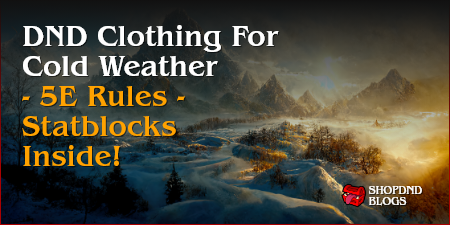DND Clothing For Cold Weather - 5E Rules - Statblocks Inside!
Whether bought from a shop, made, or discovered as loot on your adventures - cold weather DND clothing is adventuring gear your players will need as they head for colder climates. Find clothing for D&D 5E that’s perfect for your setting!
01 Background
Extremely cold conditions have been a staple of high fantasy for a long time, but particularly recently since the popularity of Game of Thrones. Many brand hoodies, t-shirts, vests, and long sleeve tees are now popular online. To a modern audience, liches and the undead are almost synonymous with icy terrain. This stems from how brutal and deadly the climate could be to a person living in mediaeval times, especially since central heating and other similar technologies didn't exist. Thicker fabrics would have to be worn to keep warm, which people would have to create from wool or other thicker materials. Some of the dnd costume styles and other apparel you might encounter are likely inspired by medieval clothing.
If you are running a 5th edition Dungeons and Dragons campaign, your players will inevitably find a reason to wade into the snow - and when they do, t-shirts just won't cut it - even if they featured modern fabrics and similar technologies like we have today - which they almost certainly won't. This will present significant challenges to characters from a low-technology society, who will need to work hard to stay covered from the cold weather, whether they an elf, goblin or any other being. Thick suits and fashion might be available as an outfit to higher class characters who can afford the price, but other characters with less money won't be able to afford these items.
For the sake of immersive role playing it’s critical to make your D&D players aware of the challenges the cold poses and find solutions with their apparel to overcome it. If you love a gritty, crunchy style of play this will be a great additional layer of rules for you and your players to work with.
02 Materials
One material frequently used in D&D 5E cold weather clothing is animal pelts. A fur lining was one of the only insulators readily available. In mediaeval times, peasants relied on small game like rabbits for their jackets while nobility could afford wolf or bear skin coats. Obviously, this fashion wasn't available to the lower classes, who would have little or no money.
In the UK you were only allowed to hunt certain animals dependent on your class in society. You could incorporate this into your table top gaming by giving nicer cold weather apparel as the reward for a quest. Perhaps your players can only source extreme cold weather apparel once they earn favour with a local lord, who will then allow them access to thicker, fuller coats and other items. We can also think about african fashion in the past and the kinds of colours and designs they might use, as a dnd campaign doesn't necessarily have to be set in a cold climate. There are other DnD adventures that you can discover outside of the West.
You can also inject your flavour by making the cold weather clothing for D&D 5E your adventurers find made from a rare or fantastical animal. Take care when doing this to consider the climate these animals are from, however. The vendor ought to be able to locally source the materials used, else they likely won’t offer much protection from the cold. The fabrics your characters search for need to be realistically accessible in the realm that you design.
03 Layers
Layers are critical to keep your players warm. The less advanced your materials are, the more layers you will need to contain heat. Of course this is different if your campaign is set in a warm climate and you're inspired by african fashion.
A base layer would typically be something comfortable and loose, like a cotton tunic. Then an insulating mid layer, often made of wool. Wool quality would vary greatly based on where and from whom raw wool was sourced. Modern-day Merino wool was monopolised by Spain for centuries in the real world, and something similar could be true in your setting. You'll need to create apparel that your characters could realistically make.
Layers could also open the door to more immersive role playing. The thick cold weather clothing for D&D 5E could limit movement, or make it harder for your players to be stealthy. Particularly if a coat’s outer shell is something hard, like scales, it could be stiff and make extra noise.
Hats or hoods are also an important element to remember. People used to wear nightcaps to keep warm at night as they had no central heating. Imagine how cold their heads could get in the wilderness!
04 Style
Your mind may jump to Scandinavian or Western European style, but many different cultures had to adapt to extreme cold. First Nations people for instance, or outside the global North there are several mountainous civilizations you could refer to. If you want to take your game in a different direction, there are also hotter continents and african fashion which you could draw on, where you'll discover different animals to make apparel from.
Bitter colds were more common in medieval times than today, thanks to the ‘little ice age’. Average temperatures dropped by about a degree across the northern hemisphere, which lead to major rivers like the Thames and the Rhine freezing over.
What feels possible or likely in the modern day is relative. In a fantasy world there is room for an event like this to spread to cultures not traditionally associated with the cold. If you’re sticking to work already done, think about how your existing civilization would adapt to a sudden drop in temperature while maintaining their cultural identity.
Perhaps your Ancient Roman analogue culture is suddenly faced with a drop in temperature, and they have had to trade sandals for more appropriate gear. They could still maintain their classic studded leather and crimson cloth aesthetic.
05 Condition
The state your clothes are in will affect their ability to do their job. The insulating properties of materials like wool will be dramatically reduced if they get wet. It is important that you get your players to take care of their cold weather clothing.
Water absorbs heat as it evaporates. You feel this every time you step out of the shower and feel a chill. If your players fall into an iced-over lake, they should take the time to dry their clothes by a fire. It would be prudent for them to bring spares, or to wrap up in their sleeping bag as they do this.
Inevitably your players will have to conduct combat in this extreme cold environment. This too poses its challenges, as if an item of clothing maintains heavy damage it will not offer proper protection until it is repaired.
06 Paraphernalia
Of course, clothing isn’t the only equipment your players will need before their journey into the icy tundra and beyond. The cold weather will pose challenges to every element of survival so if your players like to sleep it rough, they’ll need to be prepared.
If your players are accustomed to summery weather, they may require sleeping bags better prepared for the bitter cold. If they have been sleeping under the stars thus far it is probably time for them to invest in a tent.
Other camping equipment like means to start a fire (if your mages aren’t already capable) and a kettle to melt snow into drinkable water could also be requirements.
They may also need to find shoes that give them better grip. Perhaps snowshoes if the snowfall is thick, or mountaineering boots if they are going to be climbing a lot.
07 Meat and Potatoes
Rations may not go as far as they do under fairer conditions. They will likely also be harder to come by. Animals will be more scarce and harder to chase, making hunting on the road much riskier.
Food ought to last a little longer in the cold thanks to natural refrigeration (or, if your players are particularly smart, from coolers made from snow and ice). If you keep track of rations perishing, you could consider extending the ‘good-for’ date by 1.5x.
It’s recommended that you double the amount of rations required per day, per player. Walking through the harsh terrain and generating more body heat will burn more calories.
08 Some Extra Crunch
Wizards of the Coast have written some basic rules for extreme cold, included in the Dungeon Master’s Guide. However, these barely scratch the surface of how hard existing in these conditions actually is. The search for materials to make warm apparel would be difficult for characters as it is.
You could choose to make use of the exhaustion rules from the Players’ Handbook. When initiating combat in deep snow, your players will have to work twice as hard to do the same tasks.
To implement this, you could halve their movement unless they take an exhaustion saving throw. This risk-reward could be a great additional challenge for players a little too comfortable with their combat prowess.
Of course, magical enemies in the region are likely to afflict cold damage and other exhaustion-type effects. Be careful to maintain encounter difficulty balance and ensure your players are physically capable of overcoming challenges you present them.
To ensure these conditions aren’t too punishing, be sure to give your players opportunities to rest. Offer your players room to take a long rest (with adequate warmth and food) to heal all levels of exhaustion between major encounters.
09 Stat Blocks
Below are some item descriptions and stats that Dungeon Masters can utilise in D&D 5E games.
Cold Weather Clothing - Common Adventuring Gear
Heavy fur coat or cloak over thick woollen clothing. Hat or hood, fur-lined leather boots and thin fabric gloves.
While in good condition, this clothing gives the wearer advantage for saving throws against extreme cold.
Cost: 10 gp. Weight: 5 lb.
Fine Cold Weather Clothing - Rare Adventuring Gear
Coat or cloak with a fur lining, made water-resistant with a scaled or boiled-leather outer layer. Hood or a hat and scarf. Snowshoes or hiking boots and thick leather gloves.
This clothing allows the wearer to automatically succeed saving throws against extreme cold.
Cost: 15gp. Weight: 8lb.


